Subprime Loans, The Root of All (Market) Evil
Harry Koza, columnist for Canada’s Globe and Mail, thinks that, contrary to the recent upswing in sentiment, the U.S real estate market is only in the first stage of a “Triple Waterfall Event” that will end in disaster. The root of the problem? The oft-maligned sub prime market. Some stats he serves up: – From…


Harry Koza, columnist for Canada’s Globe and Mail, thinks that, contrary to the recent upswing in sentiment, the U.S real estate market is only in the first stage of a “Triple Waterfall Event” that will end in disaster. The root of the problem? The oft-maligned sub prime market. Some stats he serves up:
– From 1994 through 2003, subprime mortgage lending grew at an annual rate of 25 per cent, up tenfold in nine years.
– As of September, 2006, 80 per cent of all subprime mortgages were Option ARMs which tend to have huge payment hikes in the third year.
– More than $1 trillion of Option ARMs will have payment jumps in 2007.
– In the third quarter of 2006, 12.5 per cent of all subprime loans were already delinquent on their payments after nine months.
– In the past month or so, seven subprime lenders have gone belly up.
Not a new theory, but those numbers are a little scary.
U.S. Housing Has Potential to Blow Up Real Good [Globe & Mail]
Photo from the Nuclear Weapon Archive





People don’t like it but nothing (catastrophic) happens to NYC real estate until Wall Street blows up again as it did in the ’80s – which is going to happen in ’08-’09! Before the chorus of “how many houses can bankers buy” argument surfaces, consider the research that shows each Wall Street job creates 2 additional city jobs and 1 additional suburban job as well as the fact that wall street employment is now paying 1/3 of our tax base.
This is the (main) driver of NYC real estate not “millions of mortgage brokers and realtors” losing their jobs. One other point worth mentioning in response to 3:37 is just ask anyone in commerical real estate in NYC about how many construction workers they are laying off. These guys also make considerably more than the mostly immigrant labor that is used in the homebuilding industry throughout the country. Don’t think that the big homebuilders actually employ workers who would be subject to minimum wage etc – they hire subs who then do what they want beyond that.
Stuff’s going to slow and then take a big downturn but it’s not going to be driven in NYC by sub-Prime issues or realtors and brokers out of a job.
Brownstoner Topics Late 2007-Early ’08:
“Mr. B’s Tips on How to Refinance”
“Mortgage Fraud Hurts Everyone”
“How to List Your property with Section 8”
“Pile Driving on Atlantic Causes Brownstones to Crack”
“White Flight Part 2”
“I just got mugged on Washington: I’m thinking about leaving Brooklyn”
“Wer’re selling our Brownstone – There’s just too many black people around here”
I’m not sure I buy the idea that NYC is an exception to the rule. Sure, the real estate crash is currently much worse in other places, but how long until its effect on the national economy hits NYC? When millions of realtors, construction workers, and creative mortgage brokers across the country lose their jobs, when people aren’t able to take out loans against the equity on their houses to supplement their incomes (a common practice over the last few years), how can the national economy – and thus NYC’s economy – NOT be affected? It’s not happening yet, but it will. No brownstone is an island.
“This country is built on usury but before I read any stupid responses…”
OMG the sheer number of kooks that are out there…
Personally I feel like there is something immoral about making money buying and selling real estate.
It contributes nothing to the world. It creates desperate, greedy people. What ever happened to “neither a borrower nor a lender be”? Seems like there was something fundamentally right about that one.
New York is not nearly as leveraged or dependent on ARMs as other parts of the country. Co-ops generally do not accept creative financings.
In California, the whole state went bonkers with crazy pricing. There are not the incomes in Fresno to support 800K starter homes.
“…Again, not talking about New York, but in Cali, Texas, Arizona, it could be the S&L crisis all over again.” – 12:48
Why not New York? As the first commenter asked, what stats support such a notion?
P.S. to my 1:43 post, not that there’s anything wrong with low-income housing. But it did nearly wreck these buildings to have tenants in and out all the time, and to have cheapo landlords who didn’t fix anything.
I think there would have been much less of an increase, 1:33. And the houses would have suffered. Because it was only because people were able to take out big loans that they could even make the brownstones liveable. Then the big loans were only worth it because the brownstone market was going to high. Remember on most blocks even in the best neighborhoods, the houses had fallen into disrepair, and were chopped up into low-income apartments. We simply would not have these lovely houses restored, if it weren’t for the kind of financing people could get. It costs hundreds of thousands of dollars to save a brownstone from what happened to it in the 70’s.